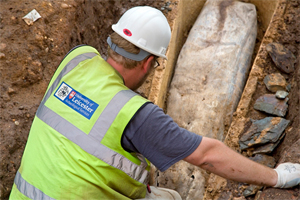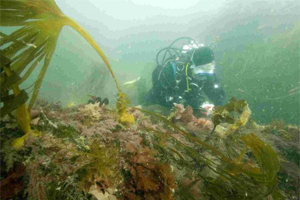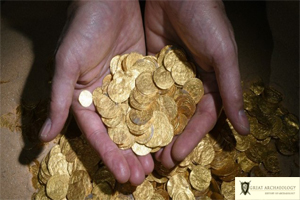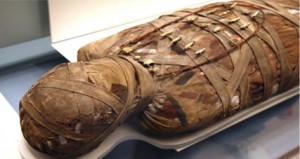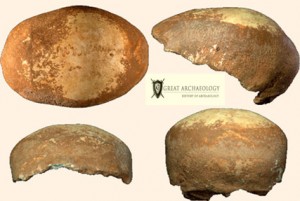Archaeologists found a strange mystery coffin near King Richard III’s grave
Archaeologists found a strange lead coffin close to King Richard III’s grave beneath a parking lot in Leicester, England, enclosed the skeleton of an elderly woman.
The Featuring an inlaid crucifix, cautiously soldered on all sides but with feet sticking out of the bottom, the lead coffin was found inside a larger limestone sarcophagus. The finding came one year after the battle-scarred leftovers of the last Plantagenet king of England. The family ruled enormous areas of Europe were unearthed.
The lady in the lead casket might have died as late as 1400, although it’s much more likely she was obscured ahead of Richard III’s death at the Battle of Bosworth.
But her tomb was the first intact medieval stone coffin unearthed in the area, it wasn’t the only grave found at the site. Nine other burials were recognized under the car park, which was basically the site of Grey Friars Church, the medieval friary of the Franciscans known to have been Richard III’s final resting place.
They said she must have been of a high status, because her bones show signs of a lifetime of eating well. She’s also not the only woman buried on the grounds of Grey Friars. In fact, Richard III is the only man archaeologists have examined from the site so far. They four other graves, including the lead coffin, belonged to women the discovery of four female burials came as somewhat of a surprise. Archaeologists said.
Richard III ruled England from 1483 until he was killed on the battlefield in the Wars of the Roses in 1485. As his rival, Henry Tudor, ascended the throne, Richard received a quick burial at the Grey Friars monastery, which was demolished in the 16th century during the Protestant Reformation.
Grey Friars’ accurate location was lost to history. In 2012, archaeologists with the University of Leicester discovered the remains of the monastery as well as Richard’s long-lost grave below a parking lot.
Much of the hype around the dig has centered on Richard, and his remains have already yielded a wealth of data on the king he died in a violent death; he ate quite well while on the throne; and he suffered from scoliosis. But archaeologists have also been studying whatever else they can find in the church.
Inside the friary’s choir where Richard III was found found two other women between ages 40 and 50 were found buried in wooden coffins Radiocarbon dating showed that they likely died between 1270 and 1400. One of the women had a hip problem that forced her to walk with a crutch, and the other women seems to have used her arms and legs frequently to lift heavy weights, suggesting a life of hard physical labor, the researchers said.
Most other monastic cemeteries in England have female-male burial ratios ranging from 1 female for every 3 males to 1 female for every 20 males, Morris said. The excavators don’t know exactly what to make of all the female burials at Grey Friars, and they were cautious about drawing any broad conclusions based on this small sample. The archaeologists recognized but didn’t examine five other burial pits on the site, and they thinks these burials were just a fraction of the total graves on the church grounds.
However, it’s believed that archaeologists will unearth more of the graves at Grey Friars any time soon.
Ancient DNA discovered in the Solent may rewrite history of farming in Europe.
We believed that Wheat was first cultured by human being about 10,500 years ago. According to the studies the first cultivations occurred in the Near East, which then spread gradually to the other regions of the world.
People in Eastern Europe started budding wheat about 8,000 to 9,000 years ago, making its way westward, crossing the English Channel some 6,000 years ago.
However, Remarkable new archaeological inventions are likely to totally rewrite a key part of British prehistory.
It is discovered by a team of researchers who have been working at the Boulder Cliff site. They have unearthed the 8,000 year old DNA sample which suggests that wheat was not grown-up in those regions or any other parts of England.
Bouldner Cliff is an archaeological site located 36 feet undersea and about 800 feet off the shore from Bouldnor, which is close to Yarmouth on the Isle of Wight.
This ancient site was first found in 1999, when the local people found a lobster that was moving a small, stone-age tool.
The scientists use a method called box sampling in order to save samples from the underwater site.
They do it by thrusting metal sampling boxes to search the newly exposed soil of the site. They then seal the box and transport it back to the outside and examine the samples in the lab.
Robin Allaby, one of the researchers implicated in the discovery, explained they discovered samples of DNA from ancient wheat. This is eccentric because there is no knowledge of wheat in England for at least another 2,000 years.
Allaby says that southern Europeans were previously growing wheat at that time, which means the wheat in England came from them.
The researchers are very eager about the latest discovery because it suggests that people from Bouldner were not as isolated from the world as it was earlier believed.
According to the researchers, the Bouldner community was in touch with other, more sophisticated Neolithic farmers from southern Europe.
After analyzing the DNA samples, the scientists concluded that the wheat was imported from somewhere else, since it was more connected to the domesticated wheat that grew in Near Eastern, that the wild wheat that grew in the Bouldner areas.
The biggest gold treasure found in Israel
The biggest gold treasure of over 2,000 ever found in Israel .That was exposed by chance off the coast of the ancient port city of Caesarea, the Israel Antiquities Authority announced Tuesday.
The gold coins dating back more than 1,000 years were found 12 meters underwater by a group of scuba divers .They reported the discovery to their the diving club manager, who then called in Israel Antiquities Authority officials. Now they look forward to to find more coins in the area.
“The gold coins are in superb condition, and despite remaining at the bottom of the sea for over 1,000 years, they did not need any preservation lab treatment,” Robert Cole, a coins specialist at the Antiquities Authority said. Some of the coins were bent and had bite marks, representing a physical authenticity check, according to Cole.
Yaakov Sharvit, head of marine archaeology at the antiquities authority, says the coins, scattered by the Fatimid Caliphate who ruled over much of the Mediterranean coast of Africa and the Middle East between the 10th and 12th centuries, were aboard a ship that sank off the Caesarean shore.
Sharvit said he hopes archaeological digs in the area will shed further light on the finding, and provide answers to the many questions about the treasure.
At least 2,000 gold coins dating back over 1,000 years were found 12 meters underwater by a group of scuba divers earlier in February, who quickly reported the discovery to their the diving club manager, who then called in Israel Antiquities Authority officials.
Antiquities Authority divers, using metal detectors, went back to the site along with the original divers, and uncovered six kilograms worth of golden coins, which had been exposed due to winter storms, according to the authority’s statement.
They expect to find more coins in the area.
Caesarea was an main port city during the Fatimid Caliphate period, serving as a key spot for maritime trade.
The coins were minted in various locations in the Fatimid kingdom, this collection included two types: a Dinar and a quarter Dinar. The oldest coin exposed was minted in the Sicilian city of Palermo, dating back to the 9th century. The latest coin was minted in 1036, confirming the ship sunk sometime after that year, though an exact date could not yet be determined.
Egyptian Mummies discovered in sewage
Two ancient Egyptian mummies with their wooden sarcophagi have been found from sewage water near El Minya, Egypt.
Egyptian Ministry of Antiquities says these Greco-Roman period mummies had been buried in tombs in a small village in northeastern Egypt, 150 miles south of Cairo. The mummies, which were found wrapped in several layers of thick linen and still in their wooden sarcophagi.
Very few human leftovers were recovered from these wrappings. The wooden sarcophagi containing the mummies had suffered wide damage due the foul water.The artifacts dated back to the Greco-Roman era of Egyptian narration, from 332 B.C. to 395 A.D.
Looting and illegal excavation or historical sites is a problem about the world, and political turmoil doesn’t make the condition easier for officials. According to experts, looters will strip Egypt of most of its archaeological heritage within the next 25 years except something is done to stop it.
A satellite survey project, invented in part by the National Geographic Society, has examined more than 4,000 archaeological sites in Egypt using Google Earth satellite imagery, and already tens of thousands of looting pits have been found across the site. Egypt employs about 1,200 guards at archaeological sites, most make only about $40 a week, leaving them tempted by giving bribes. Others may be scared off by armed gangs.
Restoration and conservation of ancient artifacts is a time overriding and exacting practice, and the loss of the sarcophagi is a blow to conservationists and the wider community of civilization and heritage preservation. The condition of the El Minya mummies is poor, but Khalifa has announced the mummies and sarcophagi will be restored as much as probable and put on display at the Hermopolis Museum.
55,000-Year-Old partial modern Skull exposed in Israel
A 55,000-year-old partial modern human skull has been exposed in Israel’s Manot Cave,the human skull which supports existing theories of modern human progression and migration. The skull is anatomically related to that of modern humans.
The findings could give the scientists applicable latest insights on when the modern humans first started interbreeding with the Neanderthals.
According to the scientists, the modern humans first appeared between 150,000 and 200,000 years ago in Africa.
The scientist says that the modern humans started to abscond Africa and explore other regions between 60,000 and 70,000 years ago.
Researchers say that this mass dispersion still remains a scientific mystery because there are very few human fossils as proof from those times.
Researcher have newly a discovered 55,000 year old skull in Israel, which they believe, dates back to the times when recent humans started to expand out of Africa and migrate towards what is now known as Europe.
The experts who analyzed the skull remains report that the anatomy of the fossils may suggest some clues on how the early Europeans looked like.
The skull fossil was unearthed by accident in 2008, when a bulldozer was digging as part of a building project and came across a cave.
The skull was exposed in a cave in Manot, located in the northern side of Israel.
The cave had its entrance sealed by rocks which covered it about 30,000 years ago.
Ofer Marder, one of the authors of the new study, said that for more than 30,000 years the cave has been reserved like a time capsule.
This skull fossil was named Manot 1 and features only the top fraction of the skull, known as the skullcap.
According to Bruce Latimers, a paleontology expert at the Case Western Reserve University in Cleveland , the skull enclosed a brain of about 1,100 milliliters, a relatively small brain compared to that of a modern human, which is measures about 1,400 milliliters.
